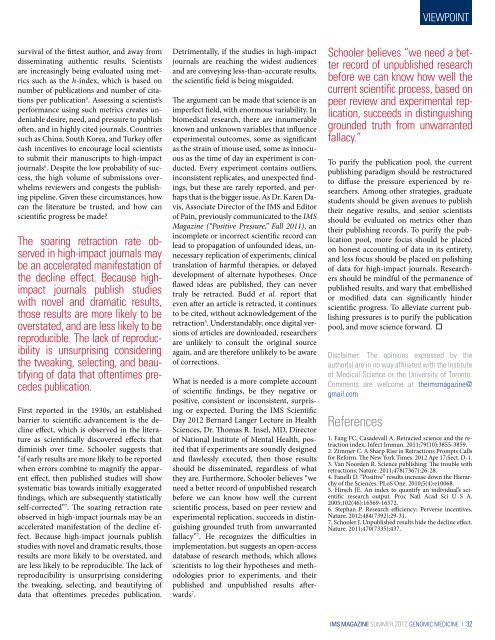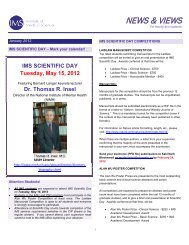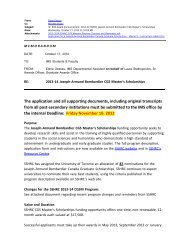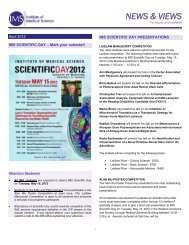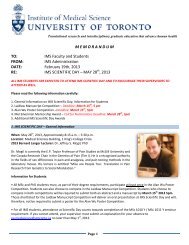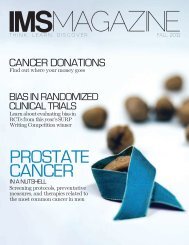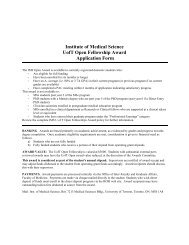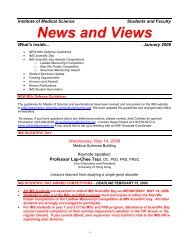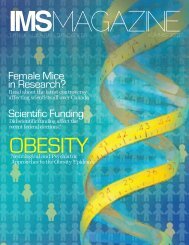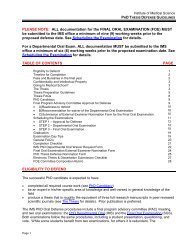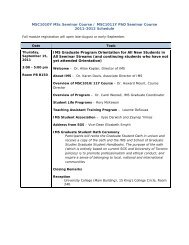IMS Magazine - Summer 2012 edition in PDF format - Institute of ...
IMS Magazine - Summer 2012 edition in PDF format - Institute of ...
IMS Magazine - Summer 2012 edition in PDF format - Institute of ...
Create successful ePaper yourself
Turn your PDF publications into a flip-book with our unique Google optimized e-Paper software.
VIEWPOINT<br />
survival <strong>of</strong> the fittest author, and away from<br />
dissem<strong>in</strong>at<strong>in</strong>g authentic results. Scientists<br />
are <strong>in</strong>creas<strong>in</strong>gly be<strong>in</strong>g evaluated us<strong>in</strong>g metrics<br />
such as the h-<strong>in</strong>dex, which is based on<br />
number <strong>of</strong> publications and number <strong>of</strong> citations<br />
per publication 5 . Assess<strong>in</strong>g a scientist’s<br />
performance us<strong>in</strong>g such metrics creates undeniable<br />
desire, need, and pressure to publish<br />
<strong>of</strong>ten, and <strong>in</strong> highly cited journals. Countries<br />
such as Ch<strong>in</strong>a, South Korea, and Turkey <strong>of</strong>fer<br />
cash <strong>in</strong>centives to encourage local scientists<br />
to submit their manuscripts to high-impact<br />
journals 6 . Despite the low probability <strong>of</strong> success,<br />
the high volume <strong>of</strong> submissions overwhelms<br />
reviewers and congests the publish<strong>in</strong>g<br />
pipel<strong>in</strong>e. Given these circumstances, how<br />
can the literature be trusted, and how can<br />
scientific progress be made?<br />
The soar<strong>in</strong>g retraction rate observed<br />
<strong>in</strong> high-impact journals may<br />
be an accelerated manifestation <strong>of</strong><br />
the decl<strong>in</strong>e effect. Because highimpact<br />
journals publish studies<br />
with novel and dramatic results,<br />
those results are more likely to be<br />
overstated, and are less likely to be<br />
reproducible. The lack <strong>of</strong> reproducibility<br />
is unsurpris<strong>in</strong>g consider<strong>in</strong>g<br />
the tweak<strong>in</strong>g, select<strong>in</strong>g, and beautify<strong>in</strong>g<br />
<strong>of</strong> data that <strong>of</strong>tentimes precedes<br />
publication.<br />
First reported <strong>in</strong> the 1930s, an established<br />
barrier to scientific advancement is the decl<strong>in</strong>e<br />
effect, which is observed <strong>in</strong> the literature<br />
as scientifically discovered effects that<br />
dim<strong>in</strong>ish over time. Schooler suggests that<br />
“if early results are more likely to be reported<br />
when errors comb<strong>in</strong>e to magnify the apparent<br />
effect, then published studies will show<br />
systematic bias towards <strong>in</strong>itially exaggerated<br />
f<strong>in</strong>d<strong>in</strong>gs, which are subsequently statistically<br />
self-corrected” 7 . The soar<strong>in</strong>g retraction rate<br />
observed <strong>in</strong> high-impact journals may be an<br />
accelerated manifestation <strong>of</strong> the decl<strong>in</strong>e effect.<br />
Because high-impact journals publish<br />
studies with novel and dramatic results, those<br />
results are more likely to be overstated, and<br />
are less likely to be reproducible. The lack <strong>of</strong><br />
reproducibility is unsurpris<strong>in</strong>g consider<strong>in</strong>g<br />
the tweak<strong>in</strong>g, select<strong>in</strong>g, and beautify<strong>in</strong>g <strong>of</strong><br />
data that <strong>of</strong>tentimes precedes publication.<br />
Detrimentally, if the studies <strong>in</strong> high-impact<br />
journals are reach<strong>in</strong>g the widest audiences<br />
and are convey<strong>in</strong>g less-than-accurate results,<br />
the scientific field is be<strong>in</strong>g misguided.<br />
The argument can be made that science is an<br />
imperfect field, with enormous variability. In<br />
biomedical research, there are <strong>in</strong>numerable<br />
known and unknown variables that <strong>in</strong>fluence<br />
experimental outcomes, some as significant<br />
as the stra<strong>in</strong> <strong>of</strong> mouse used, some as <strong>in</strong>nocuous<br />
as the time <strong>of</strong> day an experiment is conducted.<br />
Every experiment conta<strong>in</strong>s outliers,<br />
<strong>in</strong>consistent replicates, and unexpected f<strong>in</strong>d<strong>in</strong>gs,<br />
but these are rarely reported, and perhaps<br />
that is the bigger issue. As Dr. Karen Davis,<br />
Associate Director <strong>of</strong> the <strong>IMS</strong> and Editor<br />
<strong>of</strong> Pa<strong>in</strong>, previously communicated to the <strong>IMS</strong><br />
<strong>Magaz<strong>in</strong>e</strong> (“Positive Pressure,” Fall 2011), an<br />
<strong>in</strong>complete or <strong>in</strong>correct scientific record can<br />
lead to propagation <strong>of</strong> unfounded ideas, unnecessary<br />
replication <strong>of</strong> experiments, cl<strong>in</strong>ical<br />
translation <strong>of</strong> harmful therapies, or delayed<br />
development <strong>of</strong> alternate hypotheses. Once<br />
flawed ideas are published, they can never<br />
truly be retracted. Budd et al. report that<br />
even after an article is retracted, it cont<strong>in</strong>ues<br />
to be cited, without acknowledgement <strong>of</strong> the<br />
retraction 3 . Understandably, once digital versions<br />
<strong>of</strong> articles are downloaded, researchers<br />
are unlikely to consult the orig<strong>in</strong>al source<br />
aga<strong>in</strong>, and are therefore unlikely to be aware<br />
<strong>of</strong> corrections.<br />
What is needed is a more complete account<br />
<strong>of</strong> scientific f<strong>in</strong>d<strong>in</strong>gs, be they negative or<br />
positive, consistent or <strong>in</strong>consistent, surpris<strong>in</strong>g<br />
or expected. Dur<strong>in</strong>g the <strong>IMS</strong> Scientific<br />
Day <strong>2012</strong> Bernard Langer Lecture <strong>in</strong> Health<br />
Sciences, Dr. Thomas R. Insel, MD, Director<br />
<strong>of</strong> National <strong>Institute</strong> <strong>of</strong> Mental Health, posited<br />
that if experiments are soundly designed<br />
and flawlessly executed, then those results<br />
should be dissem<strong>in</strong>ated, regardless <strong>of</strong> what<br />
they are. Furthermore, Schooler believes “we<br />
need a better record <strong>of</strong> unpublished research<br />
before we can know how well the current<br />
scientific process, based on peer review and<br />
experimental replication, succeeds <strong>in</strong> dist<strong>in</strong>guish<strong>in</strong>g<br />
grounded truth from unwarranted<br />
fallacy” 7 . He recognizes the difficulties <strong>in</strong><br />
implementation, but suggests an open-access<br />
database <strong>of</strong> research methods, which allows<br />
scientists to log their hypotheses and methodologies<br />
prior to experiments, and their<br />
published and unpublished results afterwards<br />
7 .<br />
Schooler believes “we need a better<br />
record <strong>of</strong> unpublished research<br />
before we can know how well the<br />
current scientific process, based on<br />
peer review and experimental replication,<br />
succeeds <strong>in</strong> dist<strong>in</strong>guish<strong>in</strong>g<br />
grounded truth from unwarranted<br />
fallacy.”<br />
To purify the publication pool, the current<br />
publish<strong>in</strong>g paradigm should be restructured<br />
to diffuse the pressure experienced by researchers.<br />
Among other strategies, graduate<br />
students should be given avenues to publish<br />
their negative results, and senior scientists<br />
should be evaluated on metrics other than<br />
their publish<strong>in</strong>g records. To purify the publication<br />
pool, more focus should be placed<br />
on honest account<strong>in</strong>g <strong>of</strong> data <strong>in</strong> its entirety,<br />
and less focus should be placed on polish<strong>in</strong>g<br />
<strong>of</strong> data for high-impact journals. Researchers<br />
should be m<strong>in</strong>dful <strong>of</strong> the permanence <strong>of</strong><br />
published results, and wary that embellished<br />
or modified data can significantly h<strong>in</strong>der<br />
scientific progress. To alleviate current publish<strong>in</strong>g<br />
pressures is to purify the publication<br />
pool, and move science forward.<br />
Disclaimer: The op<strong>in</strong>ions expressed by the<br />
author(s) are <strong>in</strong> no way affiliated with the <strong>Institute</strong><br />
<strong>of</strong> Medical Science or the University <strong>of</strong> Toronto.<br />
Comments are welcome at theimsmagaz<strong>in</strong>e@<br />
gmail.com.<br />
References<br />
1. Fang FC, Casadevall A. Retracted science and the retraction<br />
<strong>in</strong>dex. Infect Immun. 2011;79(10):3855-3859.<br />
2. Zimmer C. A Sharp Rise <strong>in</strong> Retractions Prompts Calls<br />
for Reform. The New York Times. <strong>2012</strong> Apr 17;Sect. D-1.<br />
3. Van Noorden R. Science publish<strong>in</strong>g: The trouble with<br />
retractions. Nature. 2011;478(7367):26-28.<br />
4. Fanelli D. “Positive” results <strong>in</strong>crease down the Hierarchy<br />
<strong>of</strong> the Sciences. PLoS One. 2010;5(4):e10068.<br />
5. Hirsch JE. An <strong>in</strong>dex to quantify an <strong>in</strong>dividual’s scientific<br />
research output. Proc Natl Acad Sci U S A.<br />
2005;102(46):16569-16572.<br />
6. Stephan P. Research efficiency: Perverse <strong>in</strong>centives.<br />
Nature. <strong>2012</strong>;484(7392):29-31.<br />
7. Schooler J. Unpublished results hide the decl<strong>in</strong>e effect.<br />
Nature. 2011;470(7335):437.<br />
<strong>IMS</strong> MAGAZINE SUMMER <strong>2012</strong> GENOMIC MEDICINE | 32


